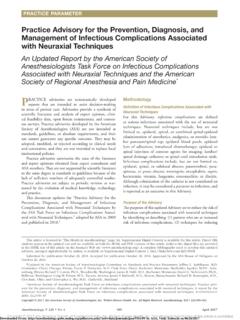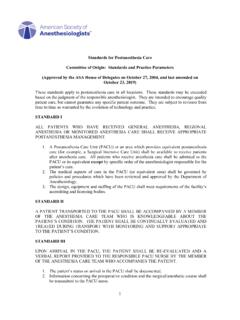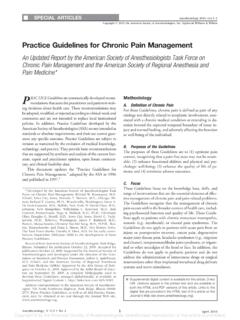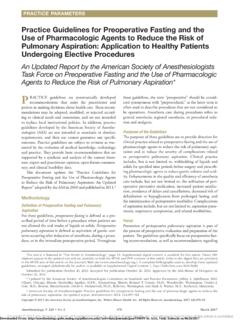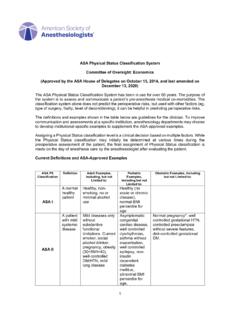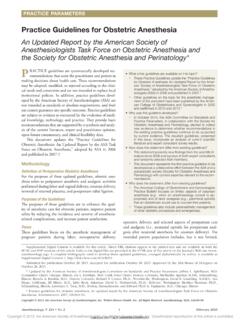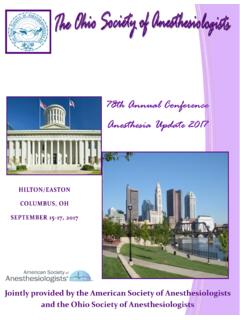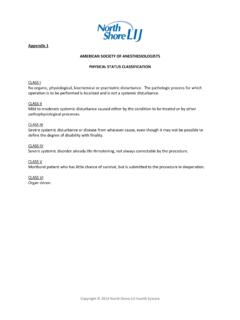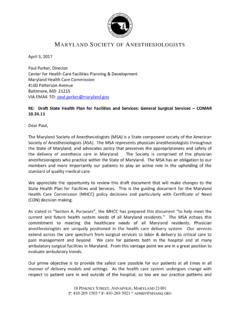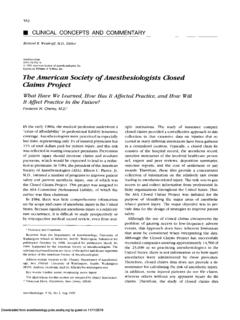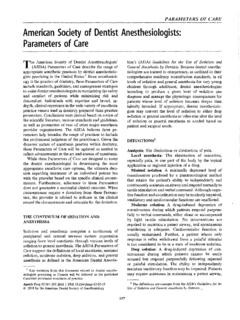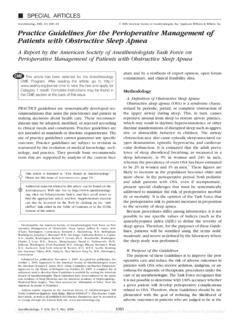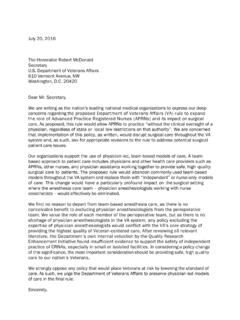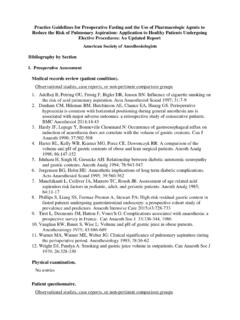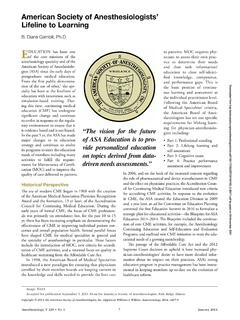Transcription of Practice Guidelines for Postanesthetic Care - asahq.org
1 Anesthesiology, V 118 No 2 1 February 2013 Practice Guidelines are systematically developed rec-ommendations that assist the practitioner and patient in making decisions about health care. These recommen-dations may be adopted, modified, or rejected according to clinical needs and constraints, and are not intended to replace local institutional policies. In addition, Practice Guidelines developed by the american society of Anesthe-siologists (ASA) are not intended as standards or absolute requirements, and their use cannot guarantee any specific outcome.
2 Practice Guidelines are subject to revision as war-ranted by the evolution of medical knowledge, technology, and Practice . They provide basic recommendations that are supported by a synthesis and analysis of the current litera-ture, expert and practitioner opinion, open forum commen-tary, and clinical feasibility document updates the Practice Guidelines for Post-anesthetic Care: A Report by the american society of Anes-thesiologists Task Force on Postanesthetic Care, adopted by the ASA in 2001 and published in 2002.
3 *MethodologyA. Definition of Postanesthetic CareA standard definition for Postanesthetic care cannot be iden-tified in the available literature. For these Practice Guide-lines, Postanesthetic care refers to those activities undertaken to manage the patient after completion of a surgical proce-dure and the concomitant primary Purpose of the Guidelines for Postanesthetic CareThe purpose of these Guidelines is to improve Postanesthetic care outcomes for patients who have just had anesthesia or sedation and analgesia care.
4 This is accomplished by evaluat-ing available evidence and providing recommendations for patient assessment, monitoring, and management with the goal of optimizing patient safety. It is expected that the recom-mendations will be individualized according to patient FocusThese Guidelines focus on the perioperative management of patients, with the goals of reducing postoperative adverse events, providing a uniform assessment of recovery, improv-ing Postanesthetic quality of life, and streamlining postop-erative care and discharge Guidelines apply to patients of all ages who have just received general anesthesia, regional anesthesia.
5 Or mod-erate or deep sedation. The Guidelines may need to be modi-fied to meet the needs of certain patient populations, such as children or the elderly. The Guidelines do not apply to Practice Guidelines for Postanesthetic CareAn Updated Report by the american society of Anesthesiologists Task Force on Postanesthetic CareUpdated by the Committee on Standards and Practice Param-eters: Jeffrey L. Apfelbaum, (Chair), Chicago, Illinois; and the Task Force on Postanesthetic Care: Jeffrey H.
6 Silverstein, (Task Force Chair), New York, New York; Frances F. Chung, , Toronto, Ontario; Richard T. Connis, , Woodinville, Wash-ington; Ralph B. Fillmore, , Dothan, Alabama; Sean E. Hunt, , Manchester, New Hampshire; David G. Nickinovich, , Bellevue, Washington; and Mark S. Schreiner, , Philadelphia, The original Guidelines were developed by the american society of Anesthesiologists Task Force on Postanesthetic Care: Jeffrey H. Sil-verstein, (Chair), New York, New York; Jeffrey L.
7 Apfelbaum, , Northbrook, Illinois; Jared C. Barlow, , Grand Island, New York; Frances F. Chung, , Toronto, Ontario; Richard T. Connis, , Woodinville, Washington; Ralph B. Fillmore, , Dothan, Alabama; Sean E. Hunt, , Manchester, New Hamp-shire; Thomas A. Joas, , San Diego, California; David G. Nicki-novich, , Bellevue, Washington; and Mark S. Schreiner, , Philadelphia, Pennsylvania. Pennsylvania. Received from american society of Anesthesiologists, Park Ridge, Illinois.
8 Submitted for publication October 18, 2012. Accepted for publication October 18, 2012. Supported by the american society of Anesthesiologists and developed under the direction of the Committee on Standards and Practice Parameters, Jeffrey L. Apfelbaum, (Chair). Approved by the ASA House of Delegates on October 17, 2012. A complete bibliography that was used to develop these updated Guidelines , arranged alphabetically by author, is available as Supplemental Digital Content 1, reprint requests to the american society of Anesthesi-ologists: 520 North Northwest Highway, Park Ridge, Illinois 60068.
9 These Practice Guidelines , as well as all ASA Practice Parameters, may be obtained at no cost through the Journal Web site, * american society of Anesthesiologists: Practice Guidelines for Postanesthetic care. Anesthesiology 2002; 96:742 2013, the american society of Anesthesiologists, Inc. Lippincott Williams & Wilkins. Anesthesiology 2013; 118:XX XXALNP ractice GuidelinesPractice deviXX Supplemental digital content is available for this article. Direct URL citations appear in the printed text and are available in both the HTML and PDF versions of this article.
10 Links to the digital files are provided in the HTML text of this article on the Journal s Web site ( ). What other guideline statements are available on this topic? These Practice Guidelines update the Practice Guidelines for Postanesthetic Care, adopted by the american society of Anesthesiologists in 2001 and published in 2002* Why was this Guideline developed? In October 2011, the Committee on Standards and Prac-tice Parameters elected to collect new evidence to deter-mine whether recommendations in the existing Practice Guideline were supported by current evidence How does this statement differ from existing Guidelines ?


